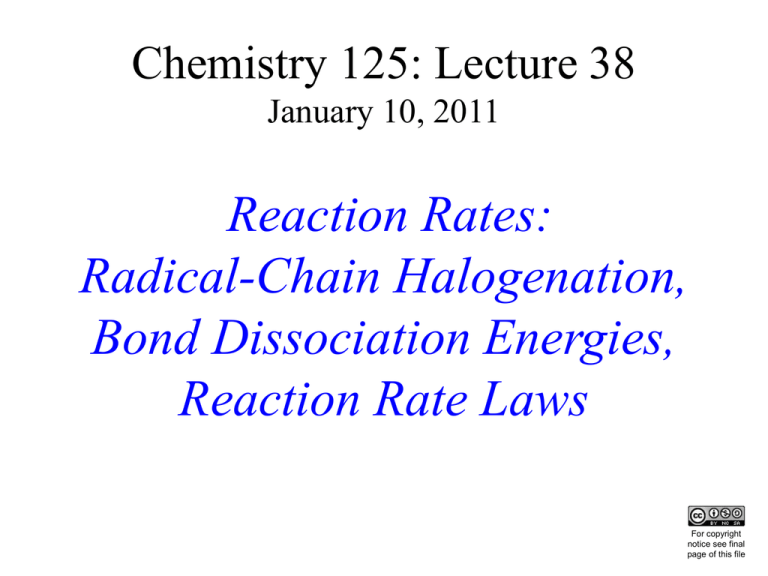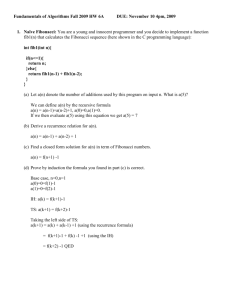
Chemistry 125: Lecture 38
January 10, 2011
Reaction Rates:
Radical-Chain Halogenation,
Bond Dissociation Energies,
Reaction Rate Laws
This
For copyright
notice see final
page of this file
Welcome Back to
Sunny New Haven
Grad TAs
Senior Peer Tutors
Jon Miller
Eva Uribe
Phillip Lichtor
Jack Qian
Julia Rogers
https://webspace.yale.edu/chem125/
Semester 1 :
Bonds & Molecular Structure
(with some thermodynamics)
Semester 2 :
Reaction Mechanisms & Synthesis
(with some spectroscopy)
How Mechanisms are Discovered and Understood
in Terms of Structure and Energy
Simplest Reactions - Bond Cleavage & Make-as-You-Break
Free-Radical Substitution: Reactivity and Selectivity
Solvent Effects on Ionic Reactions
Nucleophilic Substitution and Elimination: Proving Mechanisms
Exam 5 – February 2
Electrophilic Addition to Alkenes and Alkynes
(and the Role of Nucleophiles)
Polymers and their Properties
Conjugation, Aromaticity, & Pericyclic Reactions
Exam 6 – February 28
Spectroscopy & Synthesis
Spectroscopy for Structure and Dynamics:
UV/VIS, IR, MRI & NMR
Aromatic Substitution
Carbonyl Chemistry Oxidation & Reduction
Exam 7 – April 6
Acid Derivatives – Substitution at C=O
a-Reactivity and Classical Condensations
Carbohydrates and Fischer’s Glucose Proof
Complex Synthesis of Unnatural and Natural Products
Final Exam – May 6
Free energy determines what
can happen (equilibrium)
-DG/RT
e
K=
-(3/4)DG
= 10
Energy &
Entropy
kcal/mole
@ room Temp
But how quickly
will it happen? (kinetics)
Studying Lots of
Random Trajectories
Provides Too Much Detail
Summarize Statistically
with Collective
Enthalpy (H) & Entropy (S)
Transition “State”
G
Starting
Materials
Products
“Reaction Coordinate” Diagram
(for a one-step atom transfer)
Not a realistic trajectory, but rather
a sequence of three species
each with H and S, i.e. Free Energy (G)
Free Energy determines
what can happen (equilibrium)
-DG/RT
e
(universal)
K=
-(3/4)DG
= 10
Velocity and
of ts theory
kcal/mole
@ room Temp
how rapidly (kinetics)
‡
13
-DG
/RT
10 e
k (/sec) =
13-(3/4)DG
= 10
‡
Amount
of ts
kcal/mole
@ room Temp
Using Energies to Predict
Equilibria and Rates for
One-Step Reactions
No reaction is conceptually
simpler than breaking a bond
in the gas phase to give
atoms or free radicals.
BondDissn Energies
115
84
85
72
72
58
57
99
111
113
90
89
89
105
111
127
85
85
97
74
122
85
74
73
84
63
59
72
57
56
67
51
46
54
123
136.2
91
92
94
Ellison’s values as of 2003
from Barney Ellison
& his friends
Coming in April
Streitwieser, Heathcock, and Kosower (1992)
Ellison I
Larger halogen
Poorer overlap with H
(at normal bond distance)
& less e-transfer to halogen
H •
H •
•
•
••
F
I
••
less e-stabilization
weaker bond
Diagram qualitative; not to scale.
All H-Alkyl 100 ± 5
Same trend as
H-Halogen
Special Cases
Ellison II
C-H bond unusually strong
hard
(good overlap from sp2C)
111
Ditto
Vinyl
No special stabilization
SOMO orthogonal to *)
hard Phenyl
Ditto
113
Are unusual BDE values due to unusual bonds or unusual radicals?
C-H bond normal
(sp3C , as in alkane)
easy
89
(Compared
Allyl
to what?)
Special stabilization
SOMO overlaps *)
easy Benzyl
Ditto
90
SOMOC
• Ditto
••
•
••
or
actually
••
Possibility of Halogenation
(Equilibrium)
H3C H + X X H3C X + H X
Cost
F 105 37 142 115
Cl ”
58 163 84
Br ”
46 151 72
I ”
36 141 58
136
103
88
71
Return
Profit
251
187
160
129
109
19
9
12
Possibility of Halogenation
How about rate(Equilibrium)
(which depends on Mechanism)?
H3C• •H + X• •X H3C X + H X
Cost
F 105 37 142 115
Cl ”
58 163 84
Br ”
46 151 72
I ”
36 141 58
136
103
88
71
Return
Profit
251
187
160
129
109
19
9
12
Is break-two-bonds-then-make-two a plausible Mechanism?
at RT (~300K)? 1013 10-106 = 10-93/sec No Way!
at ~3000K?
1013 10-10.6 = 250/sec Yes (unless there is a faster one)
Henry
Eyring
H2
H
Dissociation followed H
by association requires
high activation energy.
SLOW
(1935)
Make-as-you-break
“displacement” is much easier.
FAST
HHH
H
H2
H
H
"free-radical chain"
•
Cl
•
Cl H CH3
•
CH3 Cl Cl
H Cl
Make-as-you-break
“displacement” is much easier.
FAST
•
Cl
CH3Cl
Free-Radical Chain Substitution
R-H
X-H
cyclic machinery
X•preserves “radicalness”R •
R-X
X-X
Possibility of Halogenation
(Mechanism
for Reasonable Rate)
(Equilibrium)
H3C•
X•
H3C-H +
XHX
1 HX
X2
+ H33CXStep 2
2 Step
Cost
Return Profit
78
31
F 105 136
37 142 136
37 115 251 109
26
2
Cl ” 103
58 163 103
58 84 187 24
26
17
88
88 72 160 9
Br ”
46 151 46
22
34
71
71 58 129 12
I ”
36 141 36
How can we predict activation energy?
Even if we could predict the
rate of Step 1 or Step 2, how
would we reckon the overall
rate with two reaction steps?
We must learn to cope with
such Complex Reactions
Digression on Reaction Order
& Complex Reactions
The kinetic analogue of the
Law of Mass Action
(i.e. dependance of rate on concentrations)
can provide insight about
reaction mechanism.
Could use a single
tap “twice” as large
Rate
(amount per second)
Doubled Rate
Chemists can
also change
[Concentration]
Rate “Laws”: Kinetic Order
Rate = d [Prod] / d t = k concentration(s)?
Dependent on Mechanism
Discovered by Experiment
Simple One-Step Reactions
0th Order:
Rate = k
Would more sheep
give a faster rate?
0th Order Kinetics
for high [Substrate]
Photo: Antonio Vidigal by permission
“Substrate”
Catalyst e.g. enzyme
NO!
(saturation)
0
1
[Substrate]
Rate [Catalyst]1 [Substrate]
But
in substrate
at initially
low concentration.
Butfirst-order
if the catalysis
was not
recognized.
Rate “Laws”: Kinetic Order
Rate = d [Prod] / d t = k concentration(s)?
Dependent on Mechanism
Discovered by Experiment
Simple One-Step Reactions
0th Order:
Rate = k
1st Order:
Rate = k [A]
(Reasonable)
First-Order Kinetics
Product
Concentration
k = 0.69/sec
Time (sec)
First-Order Kinetics
Product
Concentration
k = 0.69/sec
Exponential Decay
Constant “Half Life”
= 0.69 / k
1/2
1/4
1/8
1/16
Starting Material
Time (sec)
Reversible First-Order Kinetics
Starting Material
k1
k-1
Product
at Equilibrium
forward rate = reverse rate
k1 [Starting Material] = k-1 [Product]
K
[Product]
=
[Starting Material]
k1
k-1
Reversible First-Order Kinetics
Starting Material
k1
k-1
Product
Concentration
Product
k1 = 0.69/sec
k-1 = 0.23/sec
(K=3)
Starting Material
Exponential Decay to Equilibrium Mixture
Half Life = 0.69 / (k1 + k-1)
Time (sec)
Rate Laws: Kinetic Order
Rate = d [Prod] / d t = k concentration(s)?
Dependent on Mechanism
Discovered by Experiment
Simple One-Step Reactions
0th Order:
1st
Order:
2nd Order:
Rate = k
Rate = k [A]
e.g.
[B] a catalyst
or
[B] >> [A]
Rate = k [A]2
or Rate = kk[A] [B] “1st Order in A”
If [B] is (effectively) constant “Pseudo” 1st Order
Concentration
Second- vs First-Order Kinetics
Slows Faster
Not Exponential
No Constant Half Life
Second Order
First Order
Time (sec)
Rate Laws: Kinetic Order
Rate = d [Prod] / d t = k concentration(s)?
Dependent on Mechanism
Discovered by Experiment
Complex Reactions
The Rate-Limiting Step
Who
Cares?
Rapid pre“equilibrium”
with starting material
reactive intermediate (low concentration)
Starting Material
k1
k-1
k2
Intermediate
Product
k2 / k-1 ≈ 1/9
k1 / k-1 ≈ 1/9
Once Int reaches
steady-state
“equilibrium” with SM,
SM / Int ≈ 9
Once Int reaches
steady-state
“equilibrium” with
SM, it yields
Prod 1/10 as fast
as it is formed.
TS2
TS1
as if 1st TS
were sole barrier
Actual
as if 2nd TS
were sole barrier
SM
Int
Prod
Flaky
Excel
Program
Available
Rate Laws: Kinetic Order
Rate = d [Prod] / d t = k concentration(s)?
Dependent on Mechanism
Discovered by Experiment
Complex Reactions
The Rate-Limiting Step
Fractional Order
End of Lecture 38
Jan. 10, 2011
Copyright © J. M. McBride 2011. Some rights reserved. Except for cited third-party materials, and those used by visiting
speakers, all content is licensed under a Creative Commons License (Attribution-NonCommercial-ShareAlike 3.0).
Use of this content constitutes your acceptance of the noted license and the terms and conditions of use.
Materials from Wikimedia Commons are denoted by the symbol
.
Third party materials may be subject to additional intellectual property notices, information, or restrictions.
The following attribution may be used when reusing material that is not identified as third-party content:
J. M. McBride, Chem 125. License: Creative Commons BY-NC-SA 3.0











